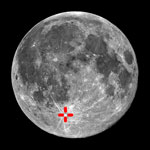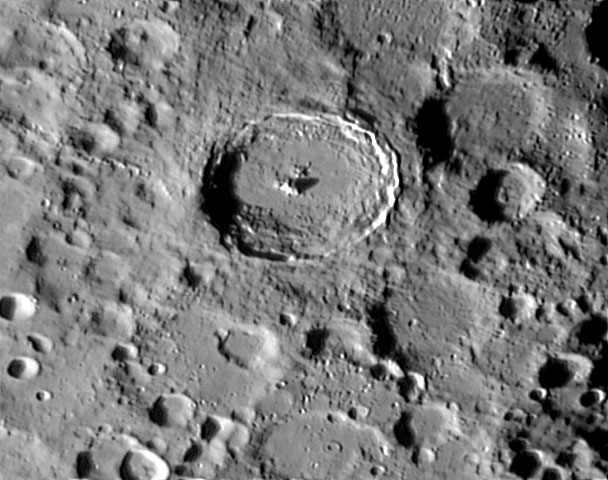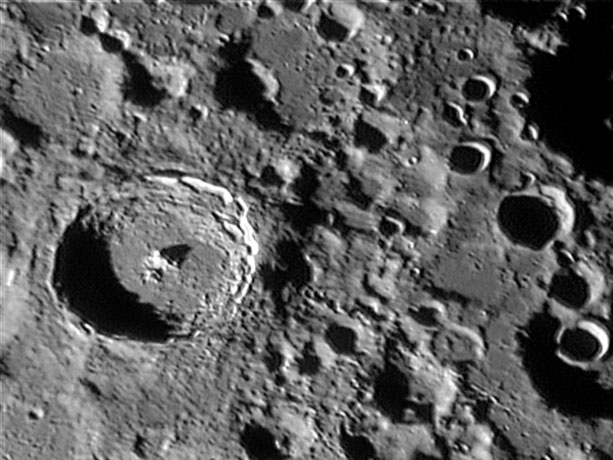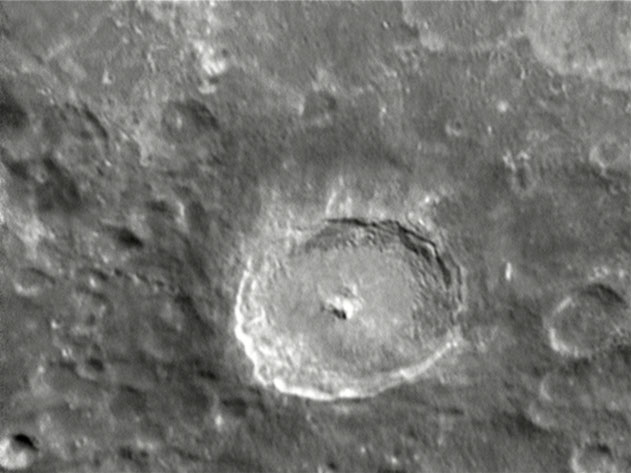|
 Tycho
est un cratère de 85 Km et profond de 4850 m situé sur le plateau
continental méridional. La surface autour de Tycho est remplie de cratères
de diverses tailles qui recouvrent des cratères encore plus anciens.
Certains des petits cratères sont des cratères secondaires formés par de
gros morceaux de l’éjecta de Tycho. Tycho est un cratère relativement jeune,
avec un âge estimé de 108 millions d'années. Age Estimé à partir des
échantillons, de l’éjecta, récupérés pendant la mission Apollo 17. Le
cratère ne montre aucun signe d'usage qui affecte des cratères plus
anciens. L'intérieur à un albédo* élevé qui est supérieur quand le soleil
est aérien. Le cratère est entouré par un système distinctif de rayon
formant de longues raies qui atteignent les 1.500 kilomètres. Les remparts
externes ont un albédo* inférieur à ceux de l'intérieur sur une longueur de
cent kilomètres, et sont exempts de rayon. Cette muraille plus foncée a pu
avoir été formée par des minerais excavés pendant l'impact. Son mur
intérieur est effondré et en terrasse. Le plancher rugueux mais presque plat
montre de petits dômes. Le plancher montre des signes du volcanisme passé,
très probablement de la fonte de roche provoquée par l'impact. La crête
centrale s’élève a 1.6 kilomètre au-dessus du plancher, et une petite crête
se tient juste au nord-est du massif primaire. Les observations infrarouges
de la surface lunaire pendant une éclipse ont démontré que Tycho se
refroidit à un taux plus lent que d'autres parties de la surface, faisant du
cratère "un point chaud". Cet effet est provoqué par la différence de
matériaux qui couvrent le cratère. La muraille du cratère a été choisie
comme cible de la mission Ranger 7. Le vaisseau spatial robotique a sans
risque atterri sur le nord du cratère en janvier 1968. Il a effectué des
dosages chimiques de la surface, trouvant une composition différente de
celle de la Mer. De ceux-çi un composant principal a été identifié comme
l’anorthosite*, un minerai riche en Aluminium.
Tycho
est un cratère de 85 Km et profond de 4850 m situé sur le plateau
continental méridional. La surface autour de Tycho est remplie de cratères
de diverses tailles qui recouvrent des cratères encore plus anciens.
Certains des petits cratères sont des cratères secondaires formés par de
gros morceaux de l’éjecta de Tycho. Tycho est un cratère relativement jeune,
avec un âge estimé de 108 millions d'années. Age Estimé à partir des
échantillons, de l’éjecta, récupérés pendant la mission Apollo 17. Le
cratère ne montre aucun signe d'usage qui affecte des cratères plus
anciens. L'intérieur à un albédo* élevé qui est supérieur quand le soleil
est aérien. Le cratère est entouré par un système distinctif de rayon
formant de longues raies qui atteignent les 1.500 kilomètres. Les remparts
externes ont un albédo* inférieur à ceux de l'intérieur sur une longueur de
cent kilomètres, et sont exempts de rayon. Cette muraille plus foncée a pu
avoir été formée par des minerais excavés pendant l'impact. Son mur
intérieur est effondré et en terrasse. Le plancher rugueux mais presque plat
montre de petits dômes. Le plancher montre des signes du volcanisme passé,
très probablement de la fonte de roche provoquée par l'impact. La crête
centrale s’élève a 1.6 kilomètre au-dessus du plancher, et une petite crête
se tient juste au nord-est du massif primaire. Les observations infrarouges
de la surface lunaire pendant une éclipse ont démontré que Tycho se
refroidit à un taux plus lent que d'autres parties de la surface, faisant du
cratère "un point chaud". Cet effet est provoqué par la différence de
matériaux qui couvrent le cratère. La muraille du cratère a été choisie
comme cible de la mission Ranger 7. Le vaisseau spatial robotique a sans
risque atterri sur le nord du cratère en janvier 1968. Il a effectué des
dosages chimiques de la surface, trouvant une composition différente de
celle de la Mer. De ceux-çi un composant principal a été identifié comme
l’anorthosite*, un minerai riche en Aluminium.
 (English version,
Wikipedia copyright)
(English version,
Wikipedia copyright)
Tycho
is a prominent lunar impact crater located in the southern lunar highlands.
To the south is Street crater; to the east Pictet, and to the
north-northeast is Sasserides crater. The surface around Tycho is replete
with craters of various differing radii, many overlapping still older
craters. Some of the smaller craters are secondary craters formed from
larger chunks of ejecta from Tycho.
Tycho is a relatively young crater, with an estimated age of 108 million
years, as estimated from samples of the crater rays recovered during the
Apollo 17 mission. The crater is sharply defined and free of the wear that
affects older craters. The interior has a high albedo that is prominent when
the sun is overhead, and the crater is surrounded by a distinctive ray
system forming long spokes that reach as long as 1,500 kilometers. Sections
of these rays can be observed even when Tycho is only illuminated by
earthlight.
The ramparts beyond the rim have a lower albedo than the interior for a
distance of over a hundred kilometers, and are free of the ray markings that
lie beyond. This darker rim may have been formed from minerals excavated
during the impact.
Its inner wall is slumped and terraced, sloping down to a rough but nearly
flat floor exhibiting small, knobby domes. The floor displays signs of past
volcanism, most likely from rock melt caused by the impact. Detailed
photographs of the floor show that it is covered in a cross-crossing array
of cracks and small hills. The central peaks rise 1.6 kilometers above the
floor, and a lesser peak stands just to the northeast of the primary massif.
Infrared observations of the lunar surface during an eclipse have
demonstrated that Tycho cools at a slower rate than other parts of the
surface, making the crater a "hot spot". This effect is caused by the
difference in materials that cover the crater.
The rim of this crater was chosen as the target of the Surveyor 7 mission.
The robotic spacecraft safely touched down north of the crater in January,
1968. The craft performed chemical measurements of the surface, finding a
composition different from the maria. From this one of the main components
of the highlands was theorized to be anorthosite, an aluminum-rich mineral.
The crater was also imaged in great detail by the Orbiter V.
From the 1950s through the 1990s, NASA aerodynamicist Dean Chapman and
others advanced the "lunar origin" theory of tektites. Chapman used complex
orbital computer models and extensive wind tunnel tests to support the
theory that the so-called Australasian tektites originated from the Rosse
ejecta ray of Tycho. Until the Rosse ray is sampled, a lunar origin for
these tektites cannot be ruled out.
This crater was drawn on lunar maps as early as 1645, when Antonius Maria
Schyrleus de Rheita depicted the bright ray system.
The Tycho crater figures prominiently in the film and book 2001: A Space
Odyssey, in which it is the location of a mysterious alien monolith which "appears
to have been deliberately buried."
|
|




 (English version,
(English version,


